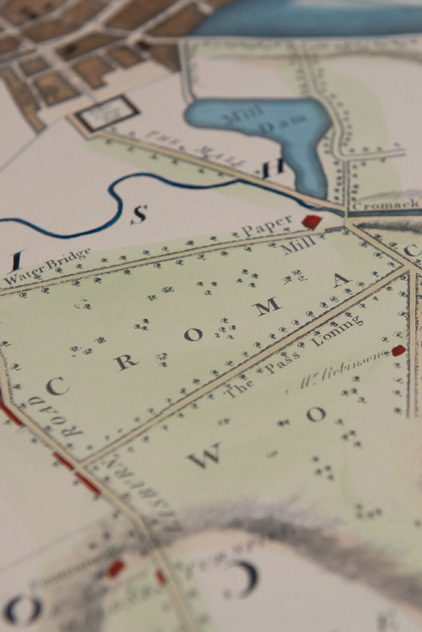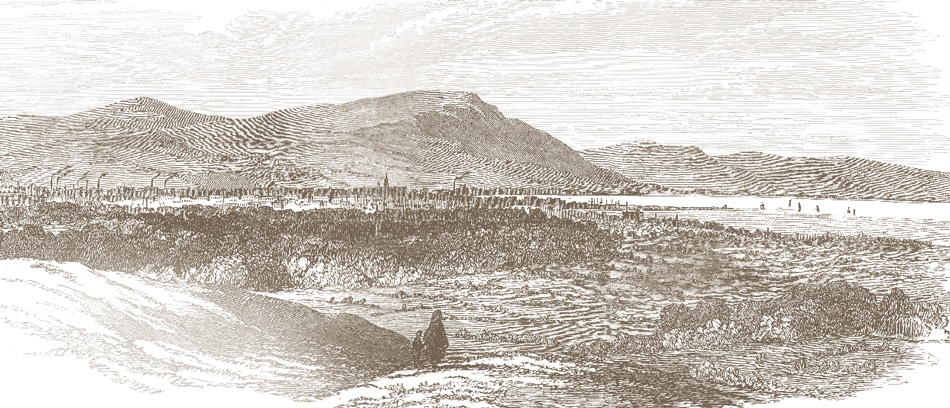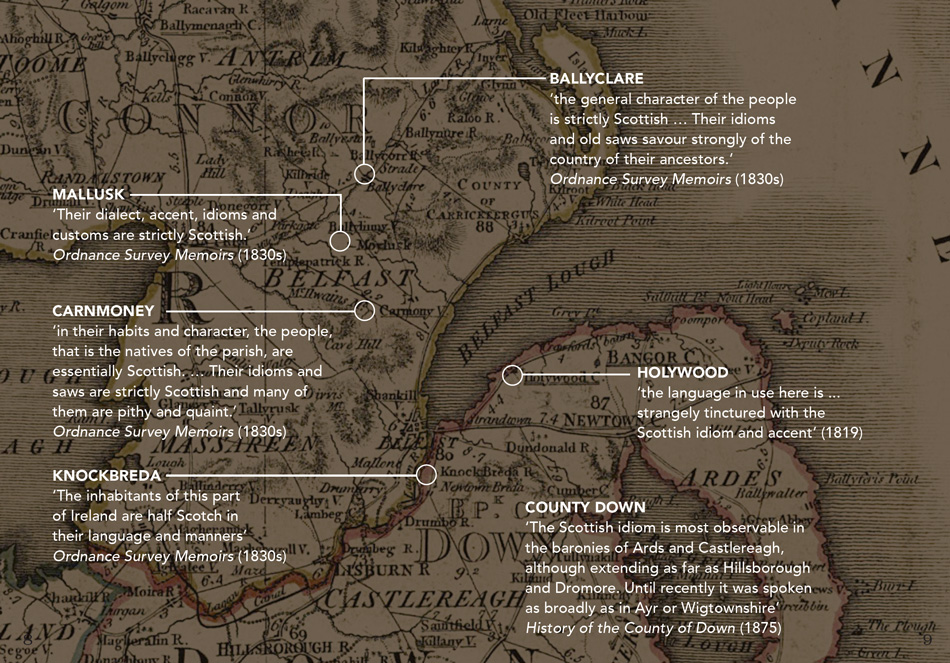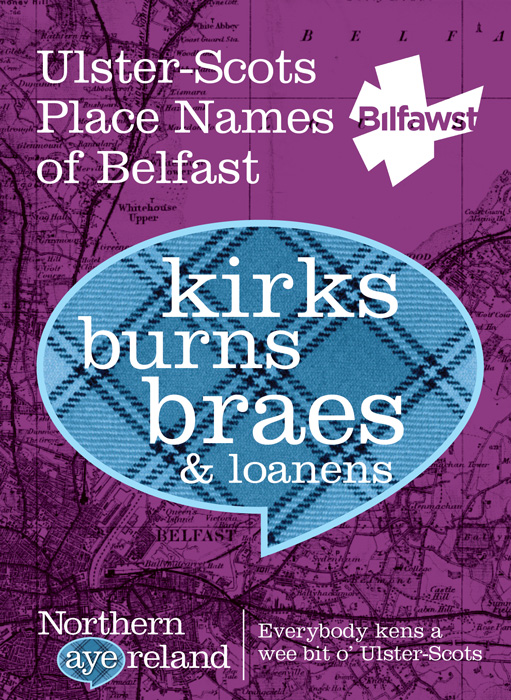Ulster-Scots Place Names of Belfast
Everybody kens awee bit o’ Ulster-Scots
Belfast has a rich Ulster-Scots heritage which stretches back over 400 years. For centuries, the town's population was largely Ulster-Scots, both in identity and speech; and the impact of this can be seen today in the Ulster-Scots place names that can be found all over the city.
Ulster’s Three Cultures
Ulster is a special place, a place apart. It has a cultural landscape that is unique in the British Isles, unlike either Britain or the rest of Ireland. This has come about through centuries of interaction between three distinct peoples, the Irish, the Scots and the English, who have been the principal elements of our community since the early 1600s.
This diversity can be seen in all sorts of ways, from the main churches we attend, to our musical traditions, our traditional dances and the sports that we play, which have their origins in England, Scotland and Ireland. It can even be seen in the symbols that we use to represent ourselves, from the shamrock, rose and thistle to the crosses of St Andrew, St George and St Patrick.
One of the greatest examples of our unique cultural wealth is our linguistic diversity. Everyone in Ulster speaks English, but we also have two cherished minority languages, Irish and Ulster-Scots, which people all over the Province are fighting to preserve and promote.
The Town of Belfast
Although Belfast was founded by an Englishman, Sir Arthur Chichester, in 1603, it soon became a magnet for lowland Scots, who made the short journey across the North Channel in search of economic opportunity and religious freedom.
By the 1630s, the number of English and Scots in the town was roughly equal, but by 1700, after a second large wave of Scottish migration in the wake of the Glorious Revolution, the town was overwhelmingly Scottish.
At the end of the 18th century, Belfast was still a small town, with a population of around 19,000, but it was essentially a Scottish and Presbyterian town. When Amyas Griffith arrived from Dublin in 1780 as Surveyor of Excise, he noted that
“the common people speak broad Scotch, and the better sort differ vastly from us, both in accent and language.”
When the French aristocrat, Le Chevalier de la Tochnaye visited Ireland in 1797 he said,
“Belfast has almost entirely the look of a Scotch town and the character of the inhabitants has considerable resemblance to that of the people of Glasgow. The way of speaking is much more Scotch than Irish.”

The Growth of Belfast
During the 19th century, Belfast expanded rapidly. In just forty years the population increased from 19,000 to 70,000 and this was largely as the result of industrialisation. William Ritchie had come over from Ayrshire in 1791 to establish what would become the Belfast shipbuilding industry; and many mills and other factories were springing up.
As the town expanded northwards, people flooded in from adjacent areas of county Antrim, which were Ulster-Scots settled and Scots speaking. The Ordnance Survey Memoirs, compiled in the 1830s, recorded of the people of the neighbouring parish of Mallusk that their
“dialect, accent and customs are strictly Scottish”.
In nearby Carnmoney, it was noted that
“their idioms and saws [sayings] are strictly Scottish”.
It was from these ‘strictly’ Ulster-Scots speaking areas that much of the population of North Belfast came. Across the Lagan, the parish of Knockbreda covered what is now east Belfast but was then largely open space and fields. Here the Ordnance Survey Memoirs reported that
“the inhabitants of this part of Ireland are half Scotch in their language and manners.”
Street after street of new houses was built to accommodate the workers in the factories and those who came from rural areas of Antrim and Down brought with them the Ulster-Scots language that they had spoken since childhood.


Ulster-Scots Place Names in Belfast
The names the Ulster-Scots of Belfast gave to features in the landscape, or to their homes or to streets that they built, have left a legacy that bears witness to the strong Scottish character of the city.
In North Belfast, on the slopes of the Cave Hill, brae (hillside) appears prominently, while in East Belfast, on the shore of the Lagan and Belfast Lough, strand (beach) provides many names. There are burns (small streams) all over the city, including Purdysburn, Minnowburn and Wedderburn in South Belfast. The Knock (prominent hill) in East Belfast also provided many street names.
Big houses were often named for a nearby geographical feature or an association with Scotland. These included Glencairn (after the Cunningham seat in Dumfriesshire) and Maryburn in West Belfast and Strathearn and Netherleigh in East Belfast. In turn they influenced the names of nearby streets.
Belfast also has over one hundred streets which are named after places in Scotland, many containing Scots language elements, including Braemar, Langholm, Lochinver, Merkland, Selkirk, and Stratheden.
Many more Ulster-Scots place names, no longer reflected in official street names, also survive in the historical record or in the memory of older Belfast people.
Ulster-Scots place name terms and definitions
| Bracken - large fern | Brae - brow of a hill / hillside |
| Burn - stream | Loney - lane |
| Cairn - pyramid of stones | Wynd - narrow lane or alley |
| Water - large stream | Knowe - hillock |
| Flush - boggy ground | Forth - fort, fortress |
| Holm - small grassy island | Kirk - church |
| Knock - hill | Lang - long |
| Loch - lake | Loop - bend or wind in a river |
| Merk - old Scots unit of money | Moss - marsh, bog |
| Mote - mound of earth | Nether - low |
| Rodden - small road / rowan | Strand - beach, shore |
| Strath - broad river valley | Wedder - castrated sheep |
| Whin - gorse |
| Bracken Hill Avenue Bracken Hill Close Bracken Hill Mews Bracken Hill View Brae Hill Crescent Brae Hill Link Brae Hill Parade Brae Hill Park Brae Hill Road Brae Hill Way Braemar Street Braeside Grove Burnside Avenue Burnside Park Burntollet Way Buttermilk Loney Cairnburn Avenue Cairnburn Crescent Cairnburn Dell Cairnburn Drive Cairnburn Gardens Cairnburn Grange Cairnburn Park Cairnburn Road Cairndale Cairnmartin Road Cairns, The Cairns Street Carnbrae Avenue Church Wynd Commons Brae Connswater Grove Connswater Link Connswater Mews Connswater Street Duncairn Avenue Duncairn Gardens Duncairn Parade Fairyknowe Drive Fairyknowe Gardens Fairyknowe Park Flush Drive Flush Gardens Flush Green Flush Park Flush Road Forthbrook Court Forth Park Forthbrook Court Forth Park Forthriver Close Forthriver Crescent Forthriver Dale Forthriver Drive Forthriver Green Forthriver Link Forthriver Parade Forthriver Park Forthriver Pass Forthriver Road Forthriver Way Glenburn Park Glencairn Crescent Glencairn Pass Glencairn Road Glencairn Street Glencairn Walk Glencairn Way Glenholm Avenue Glenholm Crescent Glenholm Park Highburn Crescent Highburn Gardens Highcairn Drive Hillburn Park Holmdene Gardens King’s Brae Kirk Crescent Kirk Street Knockbracken Park Knockbreada Drive Knockbreda Gardens Knockbreda Park Knockbreda Park Mews Knockbreda Road Knockburn Park Knockcastle Park Knockdarragh Park Knockdene Park Knockdene Park North Knockdene Park South Knockdhu Park Knock Eden Crescent Knock Eden Drive Knock Eden Grove Knock Eden Parade Knock Eden Park Knock Green |
Knock Grove Knockhill Park Knockland Park Knock Link Knocklofty Court Knocklofty Park Knockmarloch Park Knockmount Gardens Knockmount Park Knocknagoney Avenue Knocknagoney Dale Knocknagoney Drive Knocknagoney Gardens Knocknagoney Green Knocknagoney Grove Knocknagoney Park Knocknagoney Road Knocknagoney Way Knock Road Knocktern Gardens Knockvale Grove Knockvale Park Knock Way Knockwood Crescent Knockwood Drive Knockwood Grove Knockwood Park Langholm Row Lisburn Avenue Lisburn Road Lochinver Drive Loopland Crescent Loopland Drive Loopland Gardens Loopland Grove Loopland Parade Loopland Park Loopland Road Merkland Place Merkland Street Milewater Road Milewater Street Minnowburn Drive Minnowburn Gardens Minnowburn Mews MinnowburnTerrace Mossvale Street Motelands Mountain Loney (Upper Whiterock Road) Netherleigh Mews Netherleigh Park Purdysburn Hill Purdysburn Road Purdysburn Village Roddens Crescent Roddens Gardens Roddens Park Scotch Row Selkirk Row Stoneycairn Court Strand Close Strand Court Strand Mews Strand Walk Strandburn Court Strandburn Crescent Strandburn Drive Strandburn Gardens Strandburn Parade Strandburn Park Strandburn Street Strandview Street Strathearn Mews Strathearn Park Stratheden Street Strathmore Park Strathmore Park North Strathmore Park South Strathroy Park Tillysburn Drive Tillysburn Grove Tillysburn Park Upper Knockbreda Road Wedderburn Avenue Wedderburn Gardens Whincroft Road Whincroft Way Whinny Heights Whinny Hill Drive White Brae Willowholme Crescent Willowholme Drive Willowholme Parade Willowholme Street Woodburn Drive Woodburn Street |

